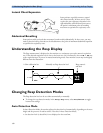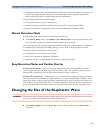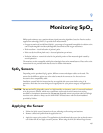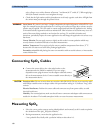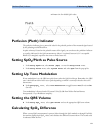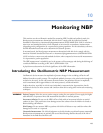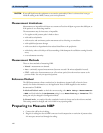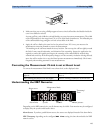
Assessing a Suspicious SpO
2
Reading 9Monitoring SpO
2
139
– has not changed in its thickness (for example, due to edema), causing an improper fit of the
sensor.
WARNING Inspect the application site every two to three hours to ensure skin quality and correct optical
alignment. If the skin quality changes, move the sensor to another site. Change the application site at
least every four hours.
Using an SpO
2
sensor during MR imaging can cause severe burns. Minimize this risk by positioning
the cable so that no inductive loops are formed. If the sensor does not appear to be operating properly,
remove it immediately from the patient.
CAUTION Injected dyes such as methylene blue, or intravascular dyshemoglobins such as methemoglobin and
carboxyhemoglobin may lead to inaccurate measurements.
Interference can be caused by:
• High levels of ambient light. (Hint: cover application site with opaque material.)
• Electromagnetic interference.
• Excessive patient movement and vibration.
Assessing a Suspicious SpO
2
Reading
Traditionally, pulse rate from SpO
2
was compared with heart rate from ECG to confirm the validity of
the SpO
2
reading. With newer algorithms, such as FAST-SpO
2
, this is no longer a valid criteria
because the correct calculation of SpO
2
is not directly linked to the correct detection of each pulse.
When pulse rate is very low, or strong arrhythmia is present, the SpO
2
/Pleth pulse rate may differ from
the heart rate calculated from ECG but this does not indicate an inaccurate SpO
2
value.
If you doubt the measured SpO
2
, use the pleth wave and perfusion indicator instead to assess the signal
quality.




